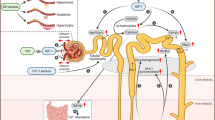Abstract
Chronic renal failure (CRF) results in complex metabolic and hormonal derangements, particularly in the GH-IGF-IGFBP axis, which can be manifest in children as growth retardation. The decreased glomerular filtration rate (GFR) in CRF is associated with increased plasma IGFBP levels, which may have an important role in inhibiting the bioavailability of IGF-I. There is a large literature from both animal and human studies showing that the administration of IGF-I can affect structure and function of normal and compromised kidneys. We propose an alternative therapeutic approach: activating bound IGF by administering molecules that bind to the IGFBPs. In initial animal studies we used a mutant IGF, an IGF displacer, that binds to IGFBPs but not to IGF receptors. In the rat this molecule activated the IGF system and produced IGF-like effects in vivo, such as increased kidney size, reduced serum creatinine, increased bone growth and increased body weight. Novel synthetic peptides have also been discovered which bind to specific IGFBPs, and we believe such molecules hold promise as therapeutic agents in renal disease.
Similar content being viewed by others
Author information
Authors and Affiliations
Additional information
Received: 12 April 1999 / Revised: 21 December 1999 / Accepted: 27 December 1999
Rights and permissions
About this article
Cite this article
Roelfsema, V., Lane, M. & Clark, R. Insulin-like growth factor binding protein (IGFBP) displacers: relevance to the treatment of renal disease. Pediatr Nephrol 14, 584–588 (2000). https://doi.org/10.1007/s004670000350
Issue Date:
DOI: https://doi.org/10.1007/s004670000350




